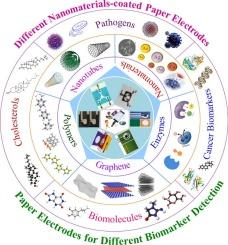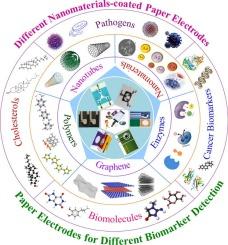纳米工程纸基电化学生物传感器:用于生物标记检测的多功能诊断工具
IF 20.3
1区 化学
Q1 CHEMISTRY, INORGANIC & NUCLEAR
引用次数: 0
摘要
COVID-19 大流行之后,对高灵敏度、微型化、非破坏性疾病生物标志物传感的需求受到极大关注。基于纳米材料涂层纸的电化学生物传感器被用来诊断各种疾病生物标记物。纳米材料提高了生物传感特性,如特异性、灵敏度、稳健性和可重复性,因而极大地推动了电化学生物传感器的发展。此外,环保型纸基电化学生物传感器在高灵敏度检测复杂样品中目标分析物方面的可行性也有所提高。纸基电极(PE)基板是实验室规模和大规模生产应用的理想选择,因为它们价格低廉,不需要微流泵,因为电解质迁移可以通过毛细作用实现,可以与试剂堆叠在一起实现无试剂应用,还可以通过折纸方法实现多相检测。因此,本综述考虑了功能纳米材料的特性,如可用于相互作用的活性表面积、生物识别物种通过微孔毛细作用附着到电极上、纤维素的导电性和光化学功能特性,以及广泛用于在纸基底上打印传感器的碳基导电浆料的电化学特性。这些结论可用于改进用于生物医学研究的 PE 生物传感器。本文讨论了最近用不同纳米材料修饰的纸基电极,用于检测各种生物标记物。本文章由计算机程序翻译,如有差异,请以英文原文为准。


Nano-engineered paper-based electrochemical biosensors: Versatile diagnostic tools for biomarker detection
After the COVID-19 pandemic, the demand for highly sensitive, miniaturized, non-destructive sensing of disease biomarkers has received significant attention. Nanomaterial-coated paper-based electrochemical biosensors were utilized to diagnose various disease biomarkers. Nanomaterials have contributed significantly to electrochemical biosensors advancements because they improve biosensing properties such as specificity, sensitivity, robustness, and reproducibility. Moreover, the viability of environmentally friendly paper-based electrochemical biosensors for the highly sensitive detection of target analytes in complicated samples has improved. Paper-based electrode (PE) substrates are desirable for lab-scale and large-scale manufacturing applications because they are inexpensive, do not require microfluidic pumps because electrolyte migration can be achieved through capillary action, can be stacked with reagents for reagent-less applications, and can achieve multiphase detection via origami-based approaches. Therefore, this review considers the properties of functional nanomaterials, such as the active surface area available for interactions, attachment of biorecognition species to the electrode via microporous capillary action, cellulose conductivity, and photochemical functional properties, and electrochemical properties of carbon-based conductive pastes that are widely used to print sensors onto paper substrates. The conclusions can be used to improve PE biosensors for biomedical research. Recent paper-based electrodes modified with different nanomaterials for detecting various biomarkers are discussed.
求助全文
通过发布文献求助,成功后即可免费获取论文全文。
去求助
来源期刊

Coordination Chemistry Reviews
化学-无机化学与核化学
CiteScore
34.30
自引率
5.30%
发文量
457
审稿时长
54 days
期刊介绍:
Coordination Chemistry Reviews offers rapid publication of review articles on current and significant topics in coordination chemistry, encompassing organometallic, supramolecular, theoretical, and bioinorganic chemistry. It also covers catalysis, materials chemistry, and metal-organic frameworks from a coordination chemistry perspective. Reviews summarize recent developments or discuss specific techniques, welcoming contributions from both established and emerging researchers.
The journal releases special issues on timely subjects, including those featuring contributions from specific regions or conferences. Occasional full-length book articles are also featured. Additionally, special volumes cover annual reviews of main group chemistry, transition metal group chemistry, and organometallic chemistry. These comprehensive reviews are vital resources for those engaged in coordination chemistry, further establishing Coordination Chemistry Reviews as a hub for insightful surveys in inorganic and physical inorganic chemistry.
 求助内容:
求助内容: 应助结果提醒方式:
应助结果提醒方式:


